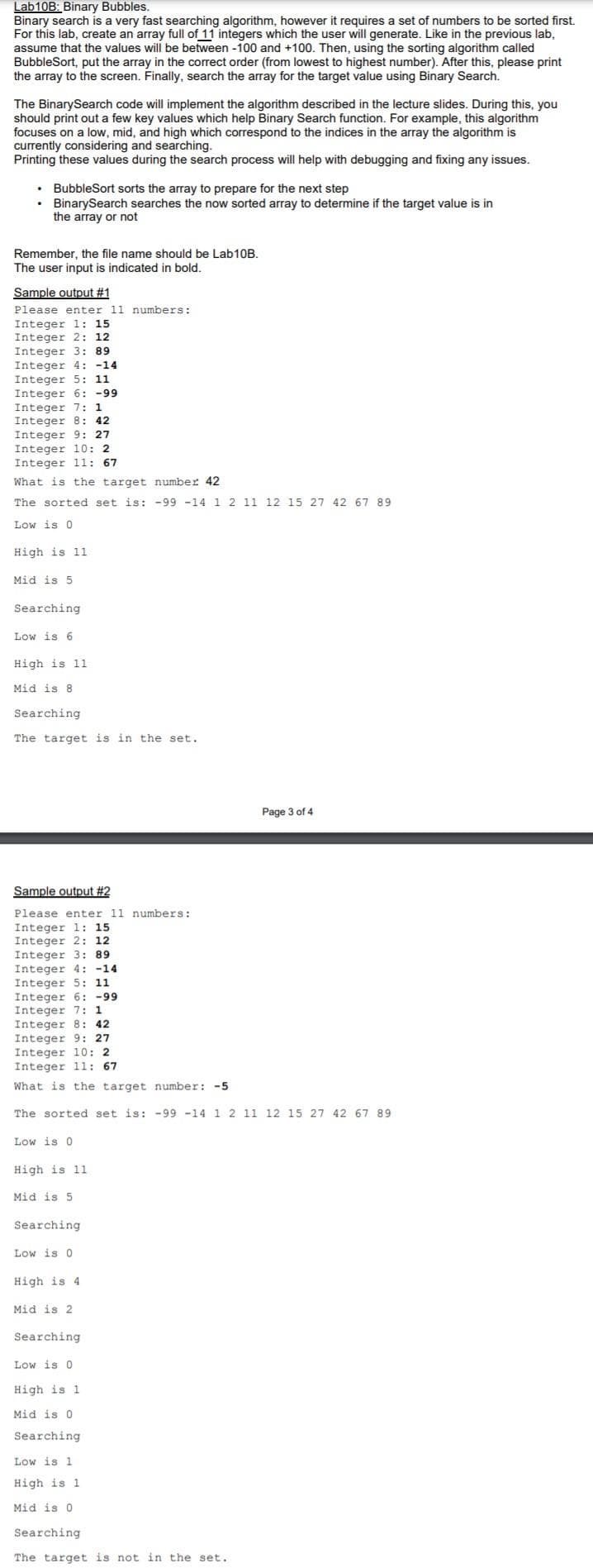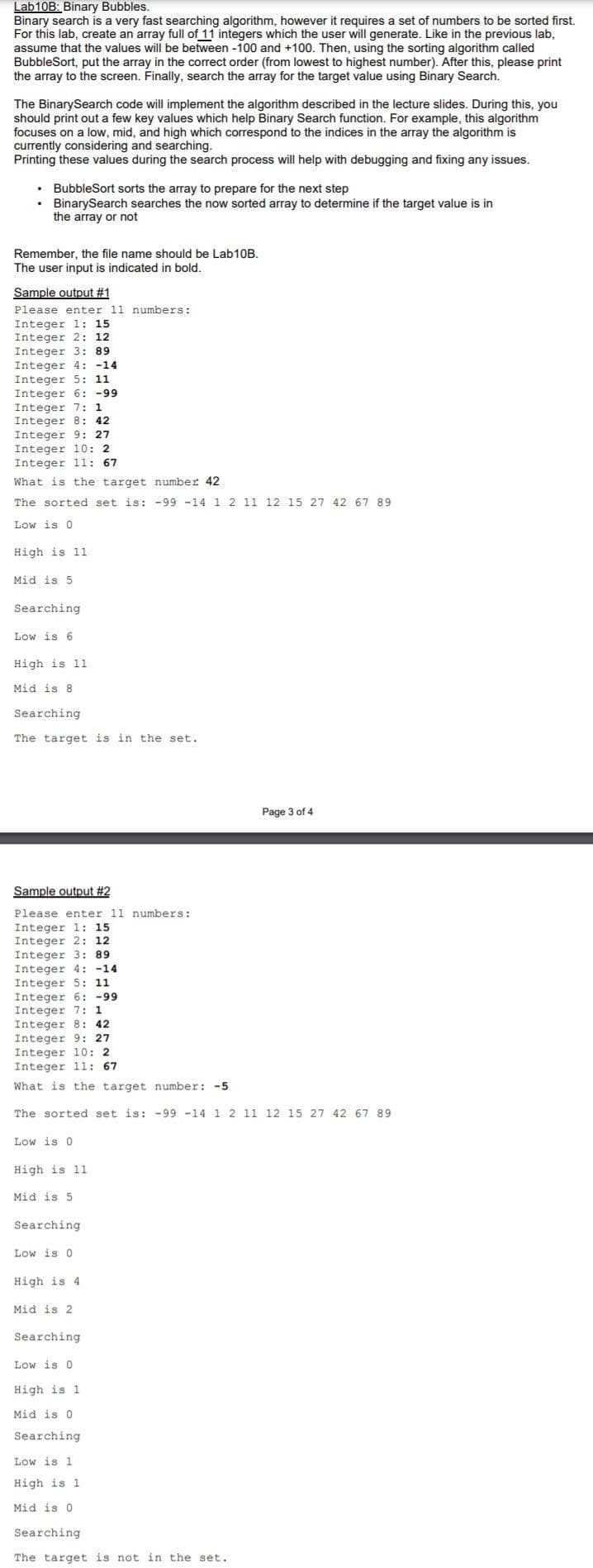Lab10B: Binary Bubbles. Binary search is a very fast searching algorithm, however it requires a set of numbers to be sorted first. For this lab, create an array full of 11 integers which the user will generate. Like in the previous lab, assume that the values will be between -100 and +100. Then, using the sorting algorithm called BubbleSort, put the array in the correct order (from lowest to highest number). After this, please print the array to the screen. Finally, search the array for the target value using Binary Search. The BinarySearch code will implement the algorithm described in the lecture slides. During this, you should print out a few key values which help Binary Search function. For example, this algorithm focuses on a low, mid, and high which correspond to the indices in the array the algorithm is currently considering and searching. Printing these values during the search process will help with debugging and fixing any issues. BubbleSort sorts the array to prepare for the next step • BinarySearch searches the now sorted array to determine if the target value is in the array or not Remember, the file name should be Lab10B. The user input is indicated in bold. Sample output #1 Please enter 11 numbers: Integer 1: 15 Integer 2: 12 Integer 3: 89 Integer 4: -14 Integer 5: 11 Integer 6: -99 Integer 7: 1 Integer 8: 42 Integer 9: 27 Integer 10: 2 Integer 11: 67 What is the target number 42 The sorted set is: -99 -14 1 2 11 12 15 27 42 67 89 Low is 0 High is 11 Mid is 5 Searching Low is 6 High is 11 Mid is 8 Searching The target is in the set.
Lab10B: Binary Bubbles. Binary search is a very fast searching algorithm, however it requires a set of numbers to be sorted first. For this lab, create an array full of 11 integers which the user will generate. Like in the previous lab, assume that the values will be between -100 and +100. Then, using the sorting algorithm called BubbleSort, put the array in the correct order (from lowest to highest number). After this, please print the array to the screen. Finally, search the array for the target value using Binary Search. The BinarySearch code will implement the algorithm described in the lecture slides. During this, you should print out a few key values which help Binary Search function. For example, this algorithm focuses on a low, mid, and high which correspond to the indices in the array the algorithm is currently considering and searching. Printing these values during the search process will help with debugging and fixing any issues. BubbleSort sorts the array to prepare for the next step • BinarySearch searches the now sorted array to determine if the target value is in the array or not Remember, the file name should be Lab10B. The user input is indicated in bold. Sample output #1 Please enter 11 numbers: Integer 1: 15 Integer 2: 12 Integer 3: 89 Integer 4: -14 Integer 5: 11 Integer 6: -99 Integer 7: 1 Integer 8: 42 Integer 9: 27 Integer 10: 2 Integer 11: 67 What is the target number 42 The sorted set is: -99 -14 1 2 11 12 15 27 42 67 89 Low is 0 High is 11 Mid is 5 Searching Low is 6 High is 11 Mid is 8 Searching The target is in the set.
Chapter6: Using Arrays
Section: Chapter Questions
Problem 10E
Related questions
Question
C++ . Please make sure code has "Enter integer 1, etc" instead of allowing you to type integers without prompt.

Transcribed Image Text:Lab10B: Binary Bubbles.
Binary search is a very fast searching algorithm, however it requires a set of numbers to be sorted first.
For this lab, create an array full of 11 integers which the user will generate. Like in the previous lab,
assume that the values will be between -100 and +100. Then, using the sorting algorithm called
BubbleSort, put the array in the correct order (from lowest to highest number). After this, please print
the array to the screen. Finally, search the array for the target value using Binary Search.
The BinarySearch code will implement the algorithm described in the lecture slides. During this, you
should print out a few key values which help Binary Search function. For example, this algorithm
focuses on a low, mid, and high which correspond to the indices in the array the algorithm is
currently considering and searching.
Printing these values during the search process will help with debugging and fixing any issues.
• BubbleSort sorts the array to prepare for the next step
• BinarySearch searches the now sorted array to determine if the target value is in
the array or not
Remember, the file name should be Lab10B.
The user input is indicated in bold.
Sample output #1
Please enter 11 numbers:
Integer 1: 15
Integer 2: 12
Integer 3: 89
Integer 4: -14
Integer 5: 11
Integer 6: -99
Integer 7: 1
Integer 8: 42
Integer 9: 27
Integer 10: 2
Integer 1l: 67
What is the target number 42
The sorted set is: -99 -14 1 2 11 12 15 27 42 67 89
Low is 0
High is 11
Mid is 5
Searching
Low is 6
High is 11
Mid is 8
Searching
The target is in the set.
Page 3 of 4
Sample output #2
Please enter 11 numbers:
Integer 1: 15
Integer 2: 12
Integer 3: 89
Integer 4: -14
Integer 5: 11
Integer 6: -99
Integer 7: 1
Integer 8: 42
Integer 9: 27
Integer 10: 2
Integer 1l: 67
What is the target number: -5
The sorted set is: -99 -14 1 2 11 12 15 27 42 67 89
Low is 0
High is 11
Mid is 5
Searching
Low is 0
High is 4
Mid is 2
Searching
Low is 0
High is 1
Mid is 0
Searching
Low is 1
High is 1
Mid is 0
Searching
The target is not in the set.

Transcribed Image Text:Lab10B: Binary Bubbles.
Binary search is a very fast searching algorithm, however it requires a set of numbers to be sorted first.
For this lab, create an array full of 11 integers which the user will generate. Like in the previous lab,
assume that the values will be between -100 and +100. Then, using the sorting algorithm called
BubbleSort, put the array in the correct order (from lowest to highest number). After this, please print
the array to the screen. Finally, search the array for the target value using Binary Search.
The BinarySearch code will implement the algorithm described in the lecture slides. During this, you
should print out a few key values which help Binary Search function. For example, this algorithm
focuses on a low, mid, and high which correspond to the indices in the array the algorithm is
currently considering and searching.
Printing these values during the search process will help with debugging and fixing any issues.
• BubbleSort sorts the array to prepare for the next step
• BinarySearch searches the now sorted array to determine if the target value is in
the array or not
Remember, the file name should be Lab10B.
The user input is indicated in bold.
Sample output #1
Please enter 11 numbers:
Integer 1: 15
Integer 2: 12
Integer 3: 89
Integer 4: -14
Integer 5: 11
Integer 6: -99
Integer 7: 1
Integer 8: 42
Integer 9: 27
Integer 10: 2
Integer 1l: 67
What is the target number 42
The sorted set is: -99 -14 1 2 11 12 15 27 42 67 89
Low is 0
High is 11
Mid is 5
Searching
Low is 6
High is 11
Mid is 8
Searching
The target is in the set.
Page 3 of 4
Sample output #2
Please enter 11 numbers:
Integer 1: 15
Integer 2: 12
Integer 3: 89
Integer 4: -14
Integer 5: 11
Integer 6: -99
Integer 7: 1
Integer 8: 42
Integer 9: 27
Integer 10: 2
Integer 1l: 67
What is the target number: -5
The sorted set is: -99 -14 1 2 11 12 15 27 42 67 89
Low is 0
High is 11
Mid is 5
Searching
Low is 0
High is 4
Mid is 2
Searching
Low is 0
High is 1
Mid is 0
Searching
Low is 1
High is 1
Mid is 0
Searching
The target is not in the set.
Expert Solution
This question has been solved!
Explore an expertly crafted, step-by-step solution for a thorough understanding of key concepts.
This is a popular solution!
Trending now
This is a popular solution!
Step by step
Solved in 2 steps with 1 images

Recommended textbooks for you

Microsoft Visual C#
Computer Science
ISBN:
9781337102100
Author:
Joyce, Farrell.
Publisher:
Cengage Learning,

EBK JAVA PROGRAMMING
Computer Science
ISBN:
9781337671385
Author:
FARRELL
Publisher:
CENGAGE LEARNING - CONSIGNMENT

Microsoft Visual C#
Computer Science
ISBN:
9781337102100
Author:
Joyce, Farrell.
Publisher:
Cengage Learning,

EBK JAVA PROGRAMMING
Computer Science
ISBN:
9781337671385
Author:
FARRELL
Publisher:
CENGAGE LEARNING - CONSIGNMENT